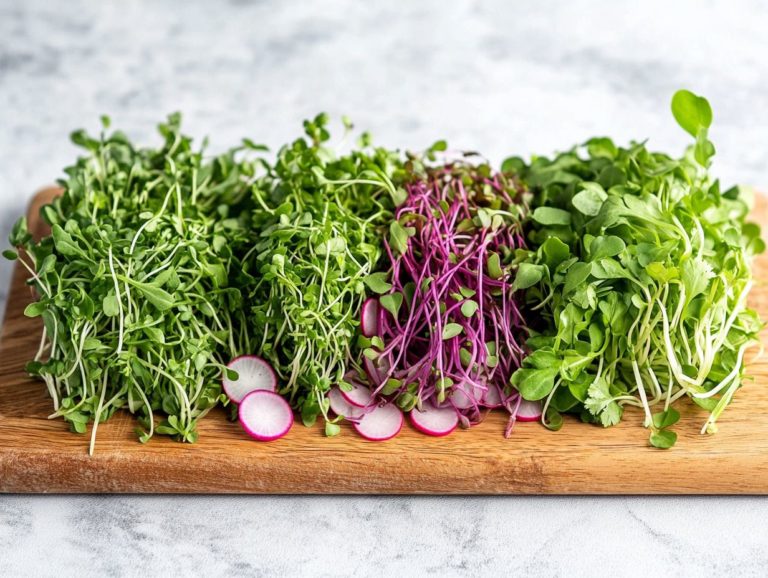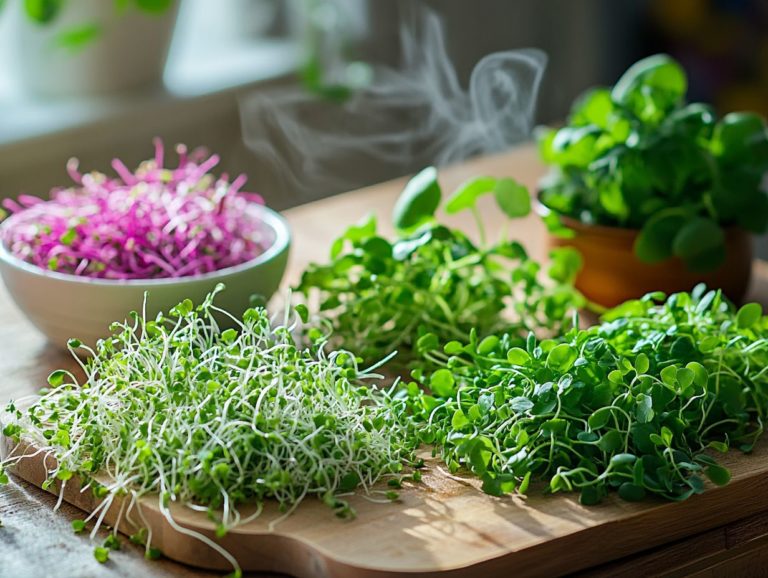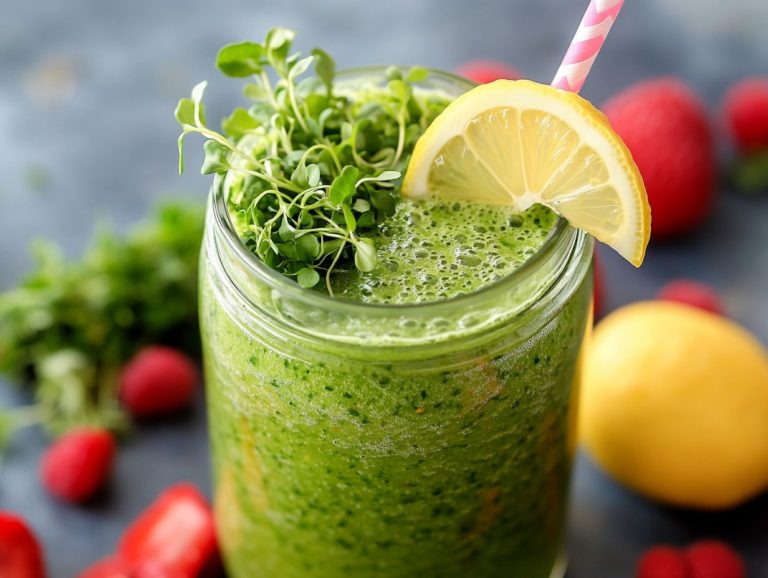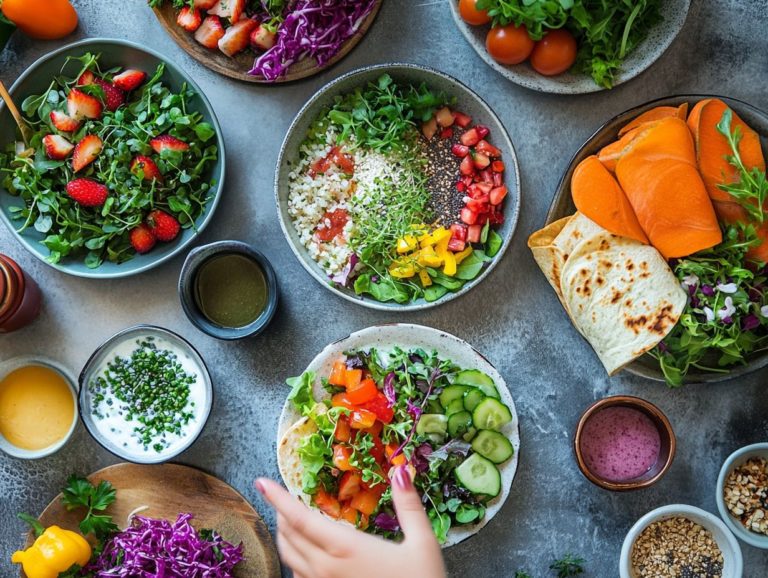13. How to Use Microgreens in Asian Dishes
Microgreens are more than just tiny plants; they re nutrient-dense powerhouses that are quickly becoming a staple in kitchens around the globe, particularly in Asian cuisine. Don’t miss out on the chance to boost your meals with these amazing ingredients!
These vibrant greens not only boost the nutritional value of your dishes but also introduce an explosion of flavor and color, transforming every meal into a visual feast.
This article delves into the advantages of incorporating microgreens into your beloved Asian recipes, showcases popular varieties, and offers practical tips for growing and storing these culinary treasures.
Whether you re an experienced chef or a home cook looking to elevate your cooking skills, there are countless inventive ways to enhance your cooking with microgreens.
Contents
- Key Takeaways:
- Benefits of Using Microgreens in Asian Dishes
- Types of Microgreens Commonly Used in Asian Dishes
- How to Incorporate Microgreens into Asian Dishes
- Tips for Growing and Storing Microgreens
- Frequently Asked Questions
- 1. What are microgreens and how do they differ from regular greens?
- 2. How can I incorporate microgreens into my Asian dishes?
- 3. Which types of microgreens work best in Asian dishes?
- 4. How should I store microgreens to keep them fresh?
- 5. Can I grow my own microgreens for use in Asian dishes?
- 6. Are there any specific health benefits of using microgreens in Asian dishes?
Key Takeaways:
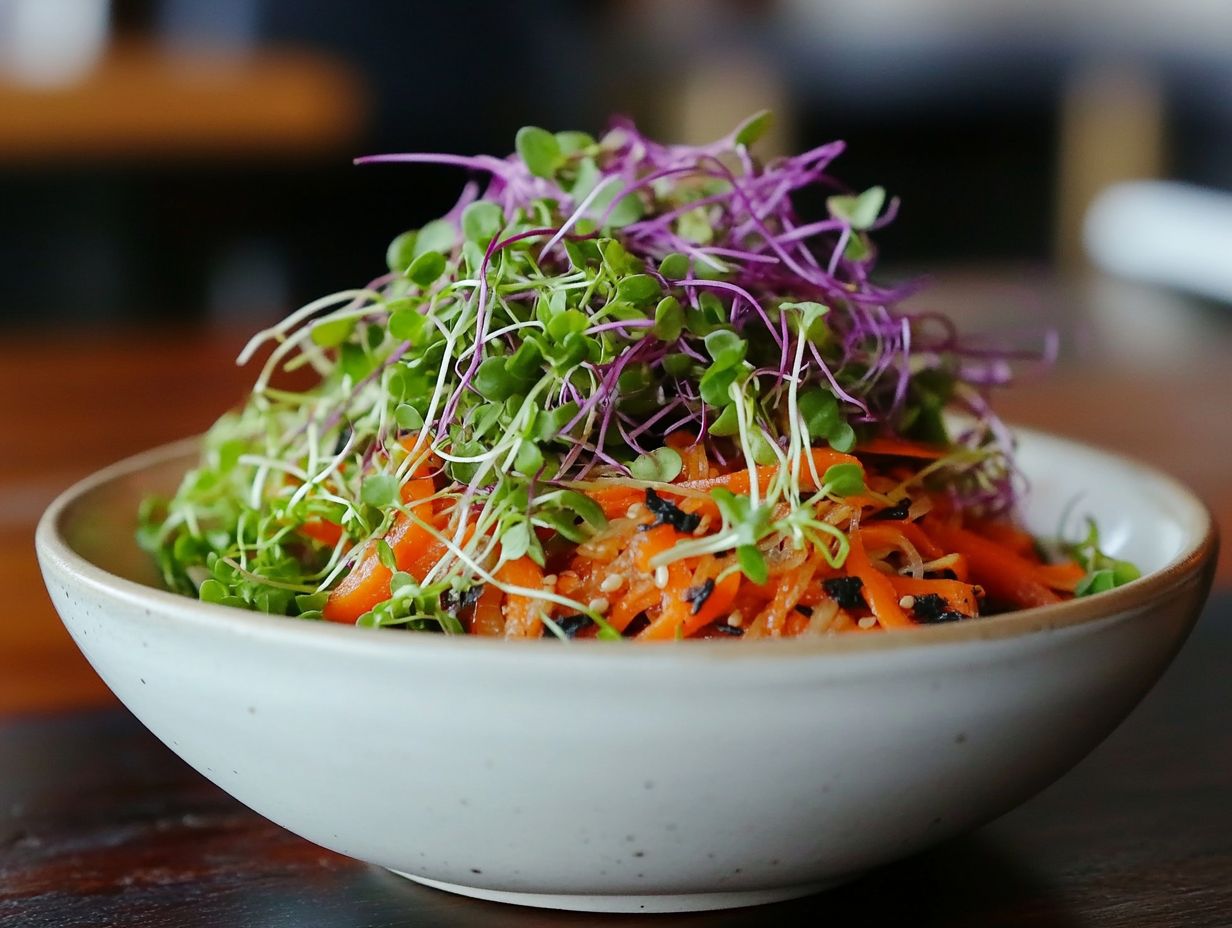
- Discover the nutritional benefits of incorporating microgreens into your Asian dishes, including an added boost of flavor and essential vitamins.
- Discover popular microgreens you can use in your dishes, including how to creatively use them.
- Learn best practices for growing and storing microgreens to ensure optimal freshness and quality in your meals.
What Are Microgreens?
Microgreens are the young seedlings of edible vegetables and herbs that you can harvest just after the first leaves have developed. They bring a delightful array of flavors and vibrant colors to your dishes, making them an essential ingredient in your cooking skills.
Packed with nutritional benefits, these tiny greens not only add versatility to your meals but also enhance both their visual appeal and taste.
Embracing the gardening revolution, growing microgreens at home has become increasingly popular. This provides you with fresh vegetables right at your fingertips to elevate your regular meals.
These miniature powerhouses come in various types, including arugula, basil, and radish, each offering unique flavor profiles and culinary possibilities. With a concentrated dose of vitamins and minerals, microgreens are celebrated for their antioxidant properties and potential health benefits, perfectly aligning with your modern focus on nutritious eating.
Whether you’re a chef or a home cook, you’ll appreciate their ability to transform simple dishes from salads to garnishes, turning your everyday meals into gourmet experiences. Their compact size makes them an excellent choice for urban gardening, seamlessly blending health trends with sustainable living practices.
Benefits of Using Microgreens in Asian Dishes
Incorporating microgreens into your Asian dishes can truly elevate your culinary experiences, infusing both nutritional value and a delightful array of flavors. These tiny yet potent greens not only make your meals healthier but also add an appealing touch to your creations.
Imagine enhancing sushi, stir-fries, and salads with unique taste profiles that beautifully complement a variety of ingredients.
By embracing microgreens, you’re not just cooking you re transforming your dishes into vibrant, flavorful masterpieces filled with bold flavors.
Nutritional Benefits
Microgreens are truly a marvel, boasting impressive nutritional benefits that can elevate your overall health. Packed with high levels of vitamins, minerals, and antioxidants, they often deliver concentrated nutrients that far surpass their mature counterparts.
Take broccoli microgreens, for instance; they’re brimming with sulforaphane, a substance that may help prevent cancer, offering mild flavors that enhance your culinary game. Then there’s kale microgreens, which offer a substantial boost of vitamins A, C, and K. Radish microgreens are loaded with vitamin E, promoting skin health and bolstering your immune system.
You can easily add these tiny greens to your daily meals. Toss them into salads, layer them onto sandwiches, or use them as a vibrant garnish for soups.
For an extra nutritious kick, blend microgreens into smoothies or nutritional shakes, enhancing both flavor and adding a delightful crunch to your drink while incorporating healthy greens like chickpeas and coriander.
Start growing microgreens today and taste the difference in your meals!
Flavor Enhancements

Microgreens come in a variety of flavors! You can find bold, spicy mustard greens or the mild notes of broccoli and cabbage microgreens. This versatility makes them perfect for many dishes. Their distinct flavors can elevate soups, salads, and garnishes in remarkable ways.
For example, the peppery notes of arugula microgreens can transform a traditional miso soup into something extraordinary. The crisp texture of radish microgreens adds a zesty crunch to Asian-style slaws, enhancing your ingredient options. By incorporating microgreens into your diet, you boost the visual appeal and introduce an intriguing layer of flavor to your meals.
Don’t hesitate to experiment with microgreens in your sauces! A cilantro variant can refresh a classic dipping sauce and lead to delightful culinary surprises. For more inspiration, check out microgreen varieties and their culinary uses. Asian cuisine particularly benefits from this innovative approach, allowing chefs like you to reinvent beloved dishes while preserving their authenticity.
Types of Microgreens Commonly Used in Asian Dishes
You ll find a delightful array of microgreens, such as Tsa Tsai Round and Small Gai Choi, in Asian cuisine. Each brings unique flavors and nutritional benefits that elevate every dish.
Popular choices include broccoli microgreens, cabbage microgreens, Tsa Tsai Round, Small Gai Choi, and mustard greens. Each adds a distinctive touch, enhancing classics like Bibimbap and sushi with vibrant taste and texture.
Popular Varieties
Among the popular varieties, broccoli and cabbage microgreens shine for their versatility and impressive health benefits! Don t overlook Tsa Tsai Round and Small Gai Choi, which each add a unique flair to your Asian culinary creations.
Broccoli microgreens are packed with nutrients! They offer a slightly peppery flavor that elevates salads and sandwiches. Bursting with vitamins A, C, and K, they re an excellent addition to any health-conscious meal.
Cabbage microgreens add a mild sweetness and satisfying crunch, making them ideal for stir-fries or as a delightful garnish on tacos. Tsa Tsai Round offers a hint of earthiness, while Small Gai Choi contributes a delicate flavor profile that enhances dishes like soups and dumplings.
Use these microgreens to boost the taste and nutrition of your meals! Make everyday dishes extraordinary!
How to Incorporate Microgreens into Asian Dishes
Incorporating microgreens into your Asian dishes is both simple and innovative! Transform ordinary meals with their vibrant flavors and nutritional benefits. Whether used as elegant garnishes or seamlessly blended into your recipes, microgreens elevate your dining experience by adding delightful texture and depth to each bite.
Creative Uses in Different Cuisines

Creative uses of microgreens extend far beyond traditional Asian dishes! You can integrate them innovatively into various cuisines. Imagine using them in fresh wraps, soups, and salads; their versatility makes them a prized ingredient for both chefs and home cooks.
Take Italian cuisine, for instance. Arugula microgreens can elevate a classic Caprese salad with a delightful peppery kick, while radish microgreens can introduce a crisp texture to a rich minestrone soup. In Mexican dishes, cilantro microgreens serve as a vibrant garnish for tacos, delivering a fresh punch that perfectly complements spicy flavors. For more insights, check out cooking with microgreen varieties.
Consider incorporating microgreens like Thai basil or coriander leaves into your homemade pesto. This adds depth and a novel flavor, ideal for pasta or as a spread on crostini, turning your food preparation into a creative process! These examples showcase just how versatile these tiny greens can be, enhancing both flavor and presentation across a range of culinary traditions. For more inspiration, check out exploring microgreen varieties in different cuisines.
Tips for Growing and Storing Microgreens
Who doesn’t love fresh greens in their dishes? To grow and store microgreens effectively, it s essential to grasp the best practices and techniques that preserve their flavor and nutritional value, especially when considering loamy soil for optimal growth.
Growing them in loamy soil creates the ideal environment for their growth. Mastering proper storage techniques is also important for ensuring their longevity.
Best Growing Practices
The most effective practices for growing microgreens revolve around selecting the right environment, such as well-draining loamy soil, while providing adequate light and moisture to maximize your growing microgreens.
These elements play a crucial role in producing vibrant, nutritious vegetables bursting with flavor. To optimize your results, focus on preparing the soil by mixing in organic compost, which enriches nutrients and enhances drainage.
Lighting is another important factor; using full-spectrum LED lights can mimic the sun s rays, stimulating optimal growth. It’s essential to keep a close eye on your watering schedule.
Microgreens thrive on consistent moisture but should never be left sitting in stagnant water, as that can lead to mold. Fine-tuning these environmental conditions can create ideal microclimates that yield robust, flavorful crops.
Proper Storage Techniques
Proper storage techniques for microgreens are essential for preserving their freshness and nutritional value, ensuring they remain a vibrant enhancement to your culinary repertoire. Store them in airtight containers in a cool environment to significantly extend their shelf life.
Along with using airtight containers, maintain a consistent temperature ideally between 32 F and 41 F to slow down deterioration. Fluctuating temperatures can cause those delicate leaves to wilt and lose their distinctive flavor.
Incorporating a damp paper towel within the container helps maintain the right humidity level, preventing moisture loss without creating a haven for mold. This approach keeps your microgreens crisp while retaining their rich, peppery taste, making them ideal for garnishing or as an ingredient in various dishes.
Use these storage tips to elevate every dish you create!
Frequently Asked Questions
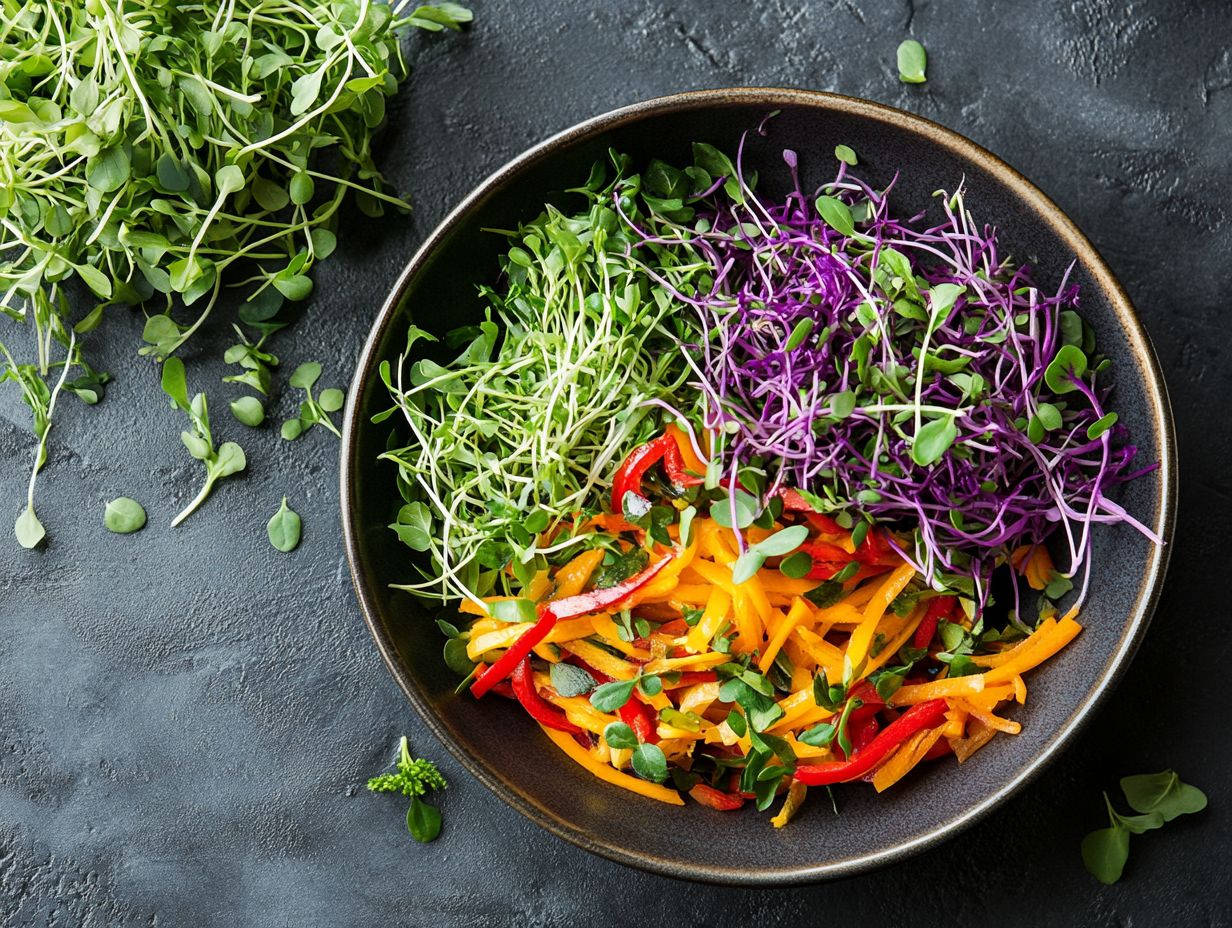
1. What are microgreens and how do they differ from regular greens?
Microgreens are young vegetable greens harvested just after they have developed their first true leaves. They differ from regular greens in that they are much smaller in size and packed with concentrated nutrients and flavors.
2. How can I incorporate microgreens into my Asian dishes?
Microgreens make a great addition to many Asian dishes, adding a burst of freshness, texture, and flavor. You can toss them into salads, use them as a topping for soups or stir-fries, or even blend them into sauces and dressings.
3. Which types of microgreens work best in Asian dishes?
Several types of microgreens work well in Asian dishes, such as cilantro, basil, radish, and mustard greens. Feel free to experiment with different varieties to find your favorite combinations!
4. How should I store microgreens to keep them fresh?
To keep your microgreens fresh, store them in the refrigerator in a sealed container or bag with a paper towel to absorb excess moisture. Use them within a few days for maximum freshness.
5. Can I grow my own microgreens for use in Asian dishes?
Absolutely! Microgreens are easy to grow at home and require minimal space and effort. You can purchase seeds or growing kits online or at your local gardening store and have fresh microgreens ready to use in as little as 7-10 days!
6. Are there any specific health benefits of using microgreens in Asian dishes?
Yes, microgreens are not only delicious but also offer a wide range of health benefits. They are rich in vitamins, minerals, and antioxidants, aiding in digestion, improving immune function, and lowering the risk of chronic diseases.

